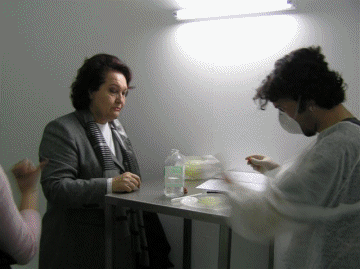| polona tratnik |
|
|||||
|
|||||
 |
Unique more photos Realizations: 2008, Ars Electronica, Linz, Austria; 2006, In Vivo In Vitro show, Athens, Greece ; 2006, U3 – Triennial of Slovenian Contemporary Art, Museum of Modern Art, Ljubljana, Slovenia . Production of the project: Kapelica Gallery, Ljubljana, Slovenia . Unique as some of Tratnik's previous projects continues to discuss the interweavement of the individual in the common microbiological flesh of the world and to question the boundaries of the individual's intimacy and privacy. It enables an insight into the micro world of the human body, and visualizes the fauna and flora of it. Samples of micro organisms of the observers are collected, cultivated and exhibited in glass vitrines under special conditions. The graveyard of the human remains becomes a fertile storehouse that enables life. The observer's intimacy is examined with an intrusively piercing eye, which sees more than usually. The observer himself is also invited to meet another aspect of his body in a dissectionary way. But the observer is also confronted with special conditions, he/she is positioned into an artificial environment for cultivating life. He/she enters the inside of an organism, but this organism is above all scientific, is a kind of laboratory organism. It is as much cold as it is warm. It contains life, namely numerous living species. Thus a human being becomes merely one of them. The confrontation is safe and sterile although the threat of an enormous quantity of the unknown species that might endanger the observer is perceptible. But the atmosphere is also exciting with its motley crowd of species in all colors and forms. The project is shown in progress so that the situation changes and is being enriched. The micro organisms gain much better conditions for growth than they have on the donor's body – in such a manner these artificial conditions enable their afterlife. The organic elements contributed by the human crowd are gathered as in a DNA bank and artificially kept alive in substitutional living environment. --- Special thanks to prof. Dimitris Kekos, Petros Katapodis, PhD, Helen Daflou and National Technical University of Athens – Department of Chemical Engineering – Biotechnology Laboratory; to Metka Krašna, PhD, Blood Transfusion Centre of Slovenia – Tissue Typing Center; to Jurij Krpan, Sandra Sajovic and Kapelica Gallery; to Jožica Puhar and Slovenian Embassy in Athens; to Helena Drnovšek-Zorko and Ministry of Foreign Affairs Slovenia; to Zoran Gorišek; to Adi Slemenjak, Stainless Steel Equipment; to Alltra, Laboratorial Glass and Equipment; to Anna Hatziyiannaki and Artopos; and to Maja Murnik. |